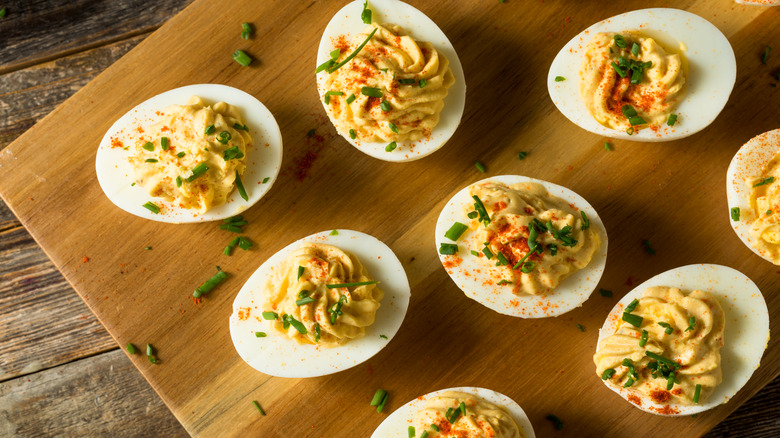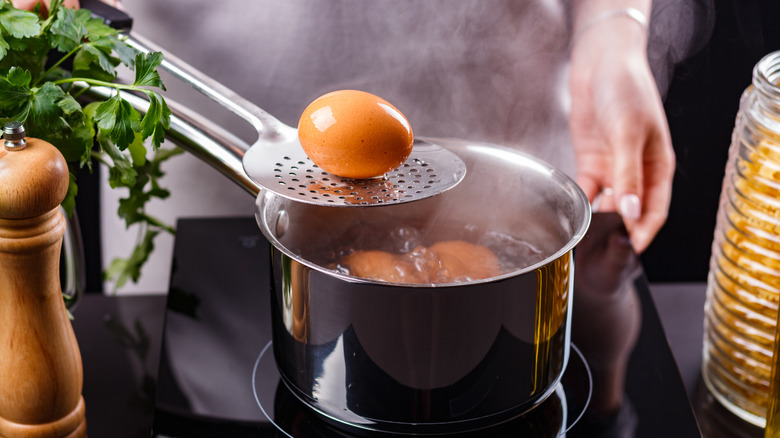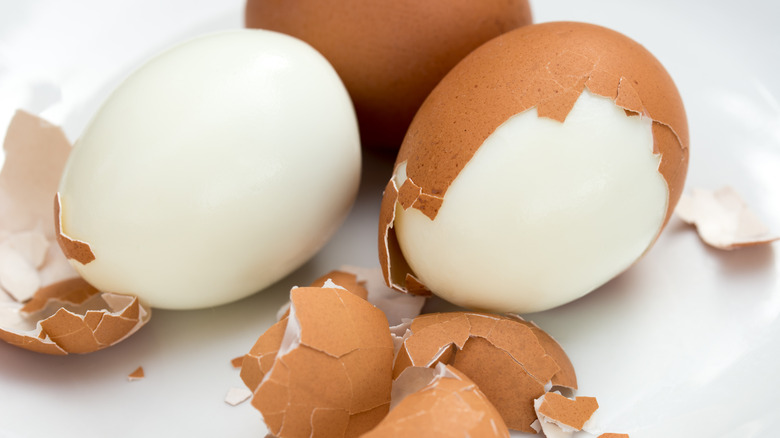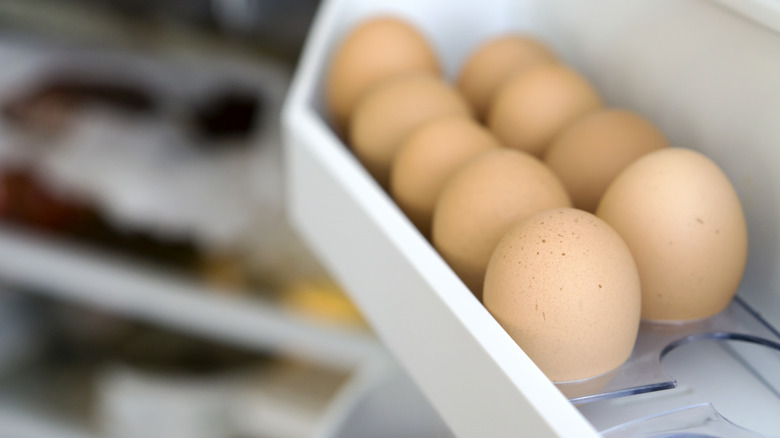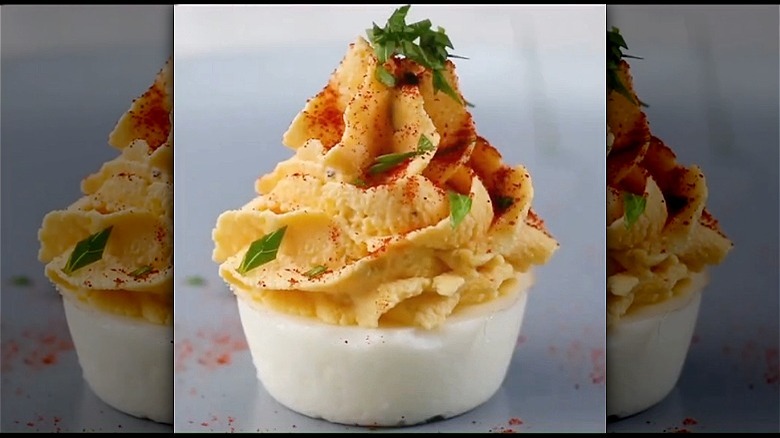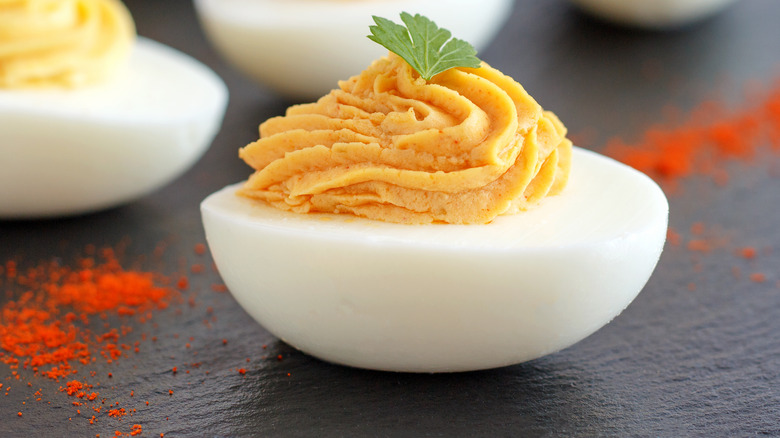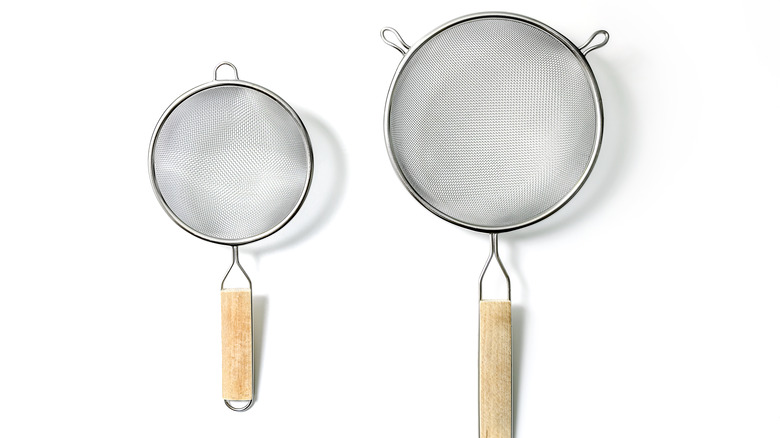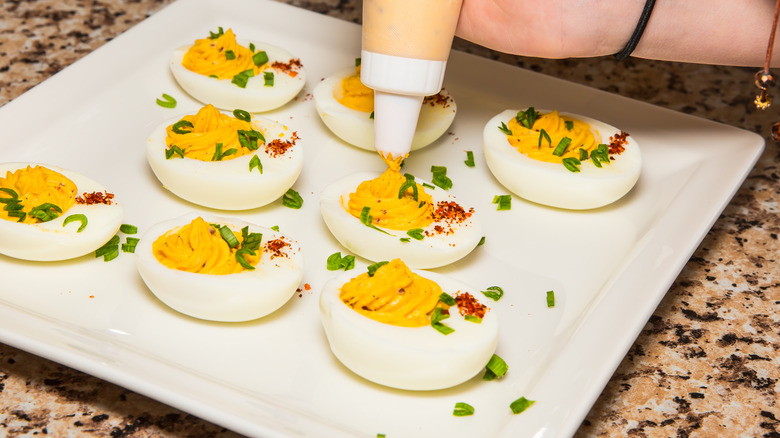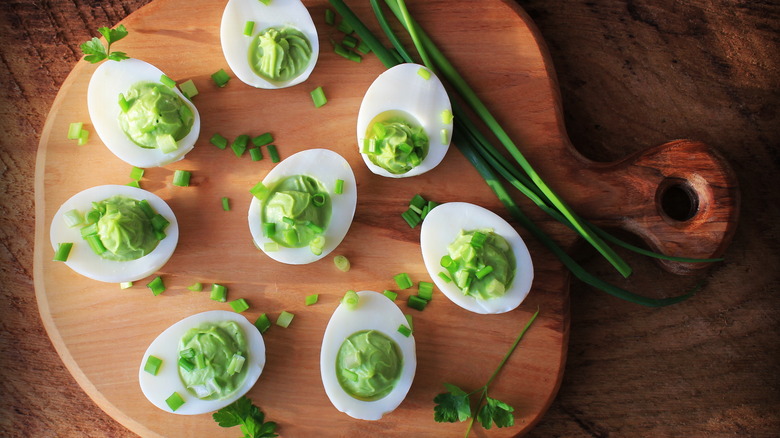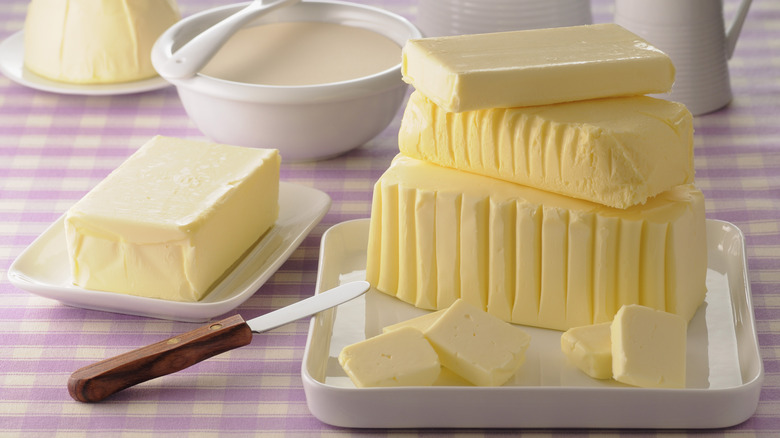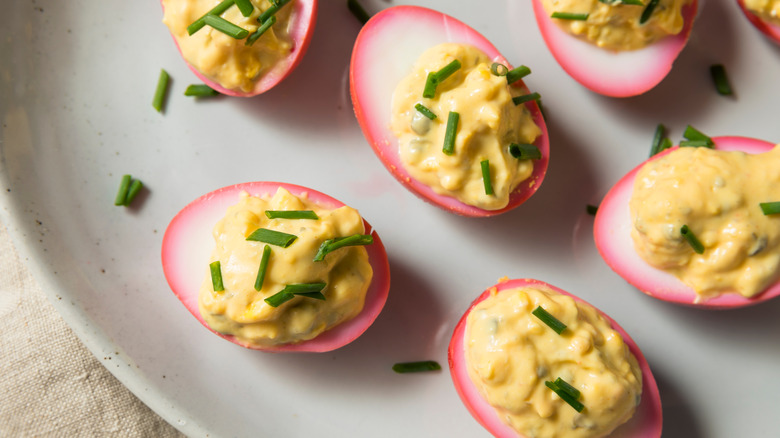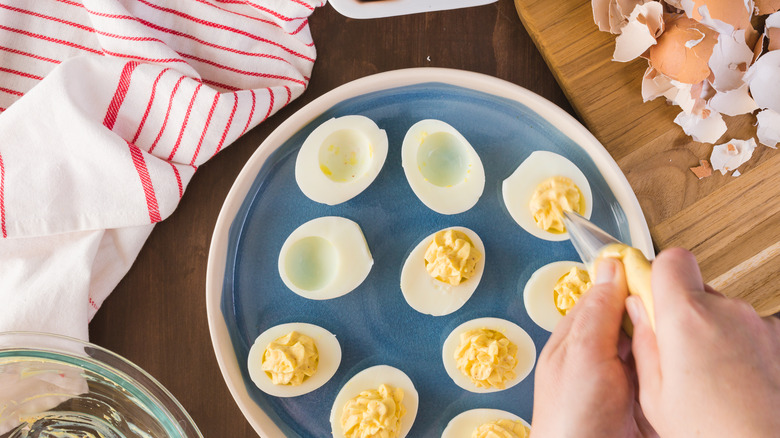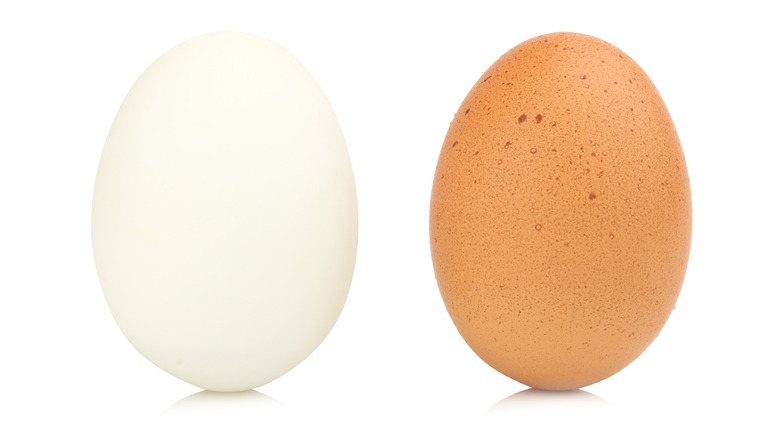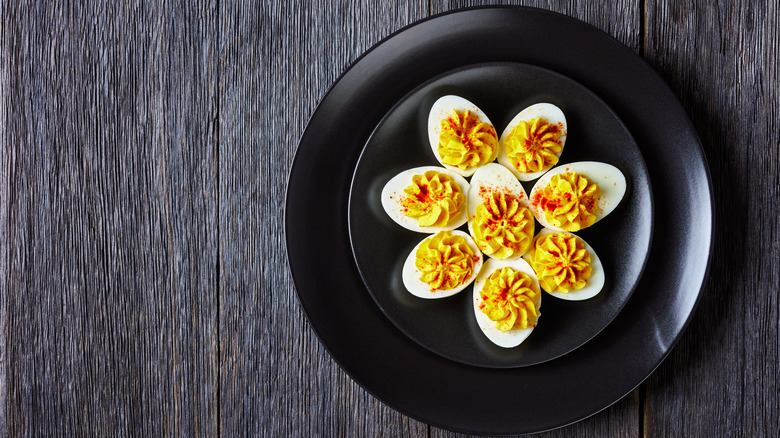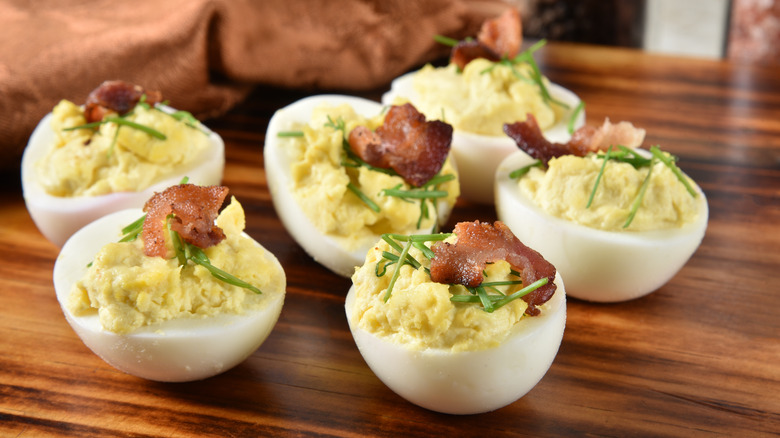15 Deviled Egg Hacks You'll Wish You Knew Sooner
If someone offered you a hard-boiled egg at a party, you would likely decline. It would be a little weird to find a plain egg on the appetizer table, right? But cut that egg in half and whip the yolks until they're luscious and creamy, and you'd be hard-pressed to say no. Mashing the yolks with mayonnaise and other flavorings completely transforms the egg, making it a popular party appetizer that's been around for centuries and never seems to go out of style.
While it's deceptively simple to make deviled eggs, the little steps along the way matter. The egg you choose, how you boil it, and the contents of the yolky filling all come together to make a bite that's either devilishly delicious or completely forgettable. To ensure your eggs don't fall into the latter category, use one (or all) of these deviled egg hacks. None of them require any special equipment, and each one works independently to make sure your eggs are hard to beat.
Boil the eggs using one of these tricks
The start of a good deviled egg centers around choosing the right egg and utilizing any boiling trick that makes it easier to peel. There's a reason some eggs are harder to peel than others, and it all boils down to how the protein bonds to the membrane in the shell. If the bond is strong, pieces of the cooked egg white will peel off with the shell, ruining the sleek look on the exterior of your deviled egg. Older eggs have a higher pH level and tend to peel easier compared to new eggs, so plan ahead and let your eggs can hang out in the fridge for about a week before boiling. If you can't wait, try adding baking soda to the boiling water, or shock the eggs in ice-cold water before peeling them to loosen up the membrane.
Starting with room-temperature eggs is another way to hack your way to better boiled eggs. The temperature difference between refrigerated eggs and boiling water can shock the egg into clinging to the outer casing, making them more difficult to peel. Even five minutes on the counter before plunging the eggs into boiling water will make a huge difference.
However you boil them, just make sure not to make the common mistake of cooking the eggs too long. Overcooked eggs will smell sulfury and have unappealing gray yolks.
Hack your way to easier-to-peel eggs
Once the eggs are completely cooled, you'll want to get the shells off without damaging the delicate egg whites. There are several ways to make it happen, but Gordon Ramsay swears by an extremely simple hack. He cracks the boiled eggs on the side of the pot and drops them into cold water, allowing the water to get underneath the shell so it will release more easily.
If that trick isn't working for you, try using a gadget-related hack. The first involves using tape to peel an egg by wrapping the circumference of the egg in packing tape. It's gently rolled on the countertop to create a network of cracks before the tape is removed, taking the eggshell along with it. Another hack uses a soup spoon: A TikToker shows how easy it is to crack the hard-boiled egg, insert the spoon into the gap between the egg and shell, and twist until the entire shell is removed. Another TikToker's method starts by cracking the bottom of the egg before it's hard-boiled. They then transfer the cooked egg into a sealable container (like a mason jar) and cover it in cold water. After shaking the container for five seconds, the egg is shaken free of its shell, resulting in a perfect egg white.
Make sure the yolks stay centered
To create the most visually stunning deviled eggs, it's important that your eggs are as symmetrical as possible. No one wants one end of the halved egg to have a thicker piece of egg white than the other! To ensure the yolk stays centered as the egg cooks, Nigella Lawson offers an easy pre-boiling step: Remove the eggs from the egg carton. These cartons store the eggs upright, but Lawson suggests that storing the eggs on their side overnight will center the yolk. Trisha Yearwood has a similar hack, except she keeps her eggs in the carton. The night before boiling her eggs, Yearwood turns the carton upside down, helping the yolk travel from the bottom of the egg to the middle.
We weren't sure about this hack until we read an interview with Maine egg farmer Lisa Steele, who told Well and Good that the blunt end of an egg contains an air sac. As the egg ages, the air sac can push the yolk around and move it inside the egg. So adjusting the egg the night before cooking should let the air do its magic and get that yolk as close to the center as possible.
Skip boiling eggs and bake them instead
If all this advice about boiling and peeling eggs raises your anxiety levels, skip the boiling altogether. A TikToker shared the brilliant idea of separating the whites and yolks into bowls before pouring each one into a mini muffin tin. The tin is placed on a baking sheet, which is filled with boiling water before being covered with aluminum foil to create steam. After steam-baking the egg "muffins," the yolks are mashed with your favorite deviled egg ingredients and piped onto the flat white using a piping bag.
There's no need to buy a mini muffin tin if you don't have one, either. You can make square eggs by baking the whites from 12 eggs in an 8-inch square baking dish. While the eggs are baking, scramble the eggs on the stovetop and mix them with any desired filling ingredients. Cut the cooked whites into 1-inch squares and pipe the yolk mixture on top. A star tip is a nice touch here to give the yolks a swirly appearance.
Bulk up the filling
Let's be real: No one is diving into a deviled egg because they love the taste of egg whites. We're all in it for that rich filling. Mayonnaise is a classic way to bulk up the yolks, but too much mayo can ruin deviled eggs. It can overpower the yolk's delicate flavor while also making the texture runny and unappealing. Adding extra yolks to the mix is a better way to create abundance. We always boil an extra few eggs, just in case we mess them up during the peeling step, so why not toss those extra yolks into the mix?
If you're running short on eggs, reach for that emergency packet of instant mashed potatoes in your pantry instead. The potato flakes will add density to the yolk mixture without overpowering the flavor. Don't have that on hand? Breadcrumbs or xanthan gum work well in a pinch, too.
Use a sieve to mash the yolks
The best deviled eggs have an airy, fluffy filling. To get there, you'll need to break down the yolks into a clump-free mixture, but overworking them with a fork or spoon can turn them into a mushy paste. Hopefully, you have our favorite tool for making creamy mashed potatoes — a sieve — because it also makes the very best deviled eggs.
These sieves are traditionally used for straining solids out of stock, dusting sugar on top of baked goods, or for sifting flour. In the case of mashed potatoes, the sieve removes lumps from cooked potatoes without overworking them into a gummy mess, and the same principle works here with egg yolks. Simply push the yolks through the sieve, using a soup spoon to scoop off any bits that stick to the strainer. From there, the smooth yolks are ready to whip with mayonnaise, vinegar, mustard, and any other seasonings.
Skip the spoon and use a piping bag
The most annoying part of filling deviled eggs is making the yolk mixture look nice inside the egg. It was so easy to pop the yolk out, but getting it back in can create a mess. Instead of using a spoon, use a piping bag (or a regular plastic bag, if you don't have one). Place the bag in a tall glass and scoop the yolk mixture into the bag. When you're ready to fill, snip the corner of the bag and squeeze the yolks back into the egg whites.
We love one TikToker's idea of mixing the filling directly in a bag instead of doing it in a bowl. The video shows the yolks being popped out into a plastic bag, which is closed to press the yolks into a crumbly consistency. Then the mayonnaise and mustard are added directly to the bag and mashed to create the filling. From there, the eggs can be filled directly without having to clean any extra bowls. As a bonus, there's no mess involved with trying to spoon the filling into the egg.
Don't limit yourself to mayonnaise
Mayonnaise is used in most deviled egg recipes for a good reason. The creamy condiment is made by emulsifying oil into egg yolks, giving it a thick texture that moistens the dry yolks while mayo's neutral flavor lets the egg's flavor shine through. That doesn't mean that mayonnaise is a required ingredient to deviled eggs, though, and you might be holding yourself back on some flavorful combinations if you don't think outside the jar.
Look to other creamy substances the next time you make deviled eggs, like sour cream, crème fraîche, or protein-packed Greek yogurt. You can also take a page out of Aida Mollenkamp's playbook and use creamy avocado in your deviled egg filling. Don't be afraid to play around with other sauces, like BBQ sauce, pesto, hummus, ranch, or Caesar salad dressing to give your eggs a little twist. These strongly-flavored sauces might overpower the eggs, but they will bring a ton of flavor to the appetizer table.
Add richness to deviled eggs with butter
If you're not already including butter in your deviled eggs, you might want to add this secret ingredient the next time you prepare this dish. Consider your last batch of eggs: They probably looked perfect when you put the platter out, but maybe turned a little flat and mushy by the end of the party. Here's where butter can help by keeping the yolky filling stable. According to Dairy Australia, butter starts to soften at around 86 degrees F and won't melt until it reaches about 95 degrees F. Chances are good the room temperature at the party is less than that.
As a bonus, the butter will add a rich flavor to the mix without overpowering the other ingredients. It will have your guests scratching their heads wondering why these eggs taste so much better than normal. To pull it off, after mixing the yolks according to your recipe, whip in two tablespoons of softened butter. Make sure you're using real butter, though, as margarine and plant-based butters have a higher water content that won't add to the egg's stability.
Marinate your hard-boiled eggs
Marinated eggs are commonly found atop steamy bowls of ramen, but there's no reason you shouldn't be using them for deviled eggs, too. The marinade adds a light, sweet-and-tangy flavor while also creating a stunning contrast between the dyed-brown exterior, white interior, and bright yellow filling. Marinated eggs are surprisingly easy to make, too. Simply combine your marinade ingredients (like soy sauce, sugar, vinegar, and water) and add peeled hard-boiled eggs. Allow the eggs to sit in the mixture for a minimum of two hours, or as long as overnight.
While soy sauce is the most common marinade ingredient, it's not your only option for marinated eggs. Ming Tsai adds an additional ingredient when making deviled eggs — loose-leaf lapsang souchong tea — to give them a smoky flavor. If you can't find this specialty tea, try using a mixture of black tea and oolong, or look to Pu'er tea instead. For a more vibrant color, make pickled eggs with beet juice. This method also gives the eggs a bright, acidic finish compared to soy sauce's salty, umami edge.
Use this trick for wobble-free eggs
Transporting a plate of deviled eggs can be tricky. You spend a ton of time making the eggs gorgeous, but the top-heavy eggs love to topple over, effectively ruining all your hard work. Sure, you can buy one of those specialty plates that has an indentation for every egg, cradling the rounded bite to prevent it from moving around. But that's probably a waste of money (and valuable storage space) unless you plan to make deviled eggs regularly. For the rest of us, Amanda Freitag comes to the rescue with her hack for wobble-free eggs.
The principle here is simple: A rounded egg won't sit flat on a plate, so the Chopped judge modifies the egg so it's no longer round on the bottom. Before adding the whites to the plate, Freitag cuts off a small portion of the bottom of the egg. This flattened piece will sit level with the plate, avoiding the dreaded topple. If you've already filled the eggs, it's too late to cut off the bottom, so try plating them on a piece of lettuce to keep them from sliding.
Prep deviled eggs in advance, but make them at the last minute
Hosting a holiday event or dinner party can be stressful, so we generally recommend prepping certain dishes ahead of time. When it comes to deviled eggs, though, Food Network's Ina Garten advises not to make them too far in advance. The expert host says that deviled eggs can be made and assembled the day before the event, but they'll need to be covered tightly in plastic wrap and stored in the fridge. Left uncovered, they'll develop an undesirable crust. Before serving them, bring the platter to room temperature for the best flavor.
Another option for making deviled eggs in advance is to boil the eggs and store them in the refrigerator for up to seven days. You can even go as far as cutting into the eggs, storing the whites in an airtight container, and keeping the prepared filling in a plastic bag or piping bag for up to two days before the event. Then, when the party gets started, it will only take you a few minutes to assemble everything onto the plate.
Use duck eggs instead of chicken eggs
Chicken eggs are a staple in most Americans' diets because they're available at pretty much every grocery store. Until recently, it wasn't easy to get other types of eggs, but the growing number of specialty stores and farmers markets around the country means other eggs are on the menu. Try making deviled eggs with other types of eggs, like quail eggs, turkey eggs, or duck eggs.
Turkey eggs are difficult to find because they don't lay as many eggs as chickens, but they're full-flavored and delicious if you can get your hands on them. Duck eggs are a little easier to locate, so they may be a better bet for your appetizer plate. Their flavor is richer than chicken eggs, with a light grassy taste that works well with deviled egg toppings. Keep in mind that they're about 50% larger than chicken eggs, so they make a very filling appetizer when prepared as deviled eggs. To cut down on the serving size, you could consider making muffin tin deviled eggs or square eggs to even out the portion size.
Choose a secret ingredient to make the filling shine
Most people have a secret ingredient for making chili or spaghetti sauce, so why not have one for deviled eggs? These secret ingredients can be added on top of your deviled egg, or you can mix it into the yolk mixture along with the mayonnaise (or mayonnaise substitute, if you're skipping the mayo). Adding a little splash of freshly squeezed lemon juice, for example, is a surefire way to take your deviled eggs up a notch. The acidity brings a burst of freshness that cuts through the fat in the yolks, making each bite a little bit brighter.
It seems that every celebrity chef has a go-to ingredient, so try them all until you find the one that speaks to your palate. Alton Brown uses a peppercorn blend instead of paprika — green, pink, white, black, and brined green peppercorns (or caper juice, if you can't find the final peppercorn) — while Chopped judge Alex Guarnaschelli prefers using cayenne pepper. Rachel Ray adds homemade Caesar salad dressing to her filling, and the Neelys add a few dashes of BBQ sauce.
Add something crunchy for texture
If you only take one hack away from this article, let it be this one. Cookbook author Molly Baz told Shape that texture is essential to how enjoyable food is. A crunchy element is often overlooked when creating a good dish because it usually has to be cooked separately, but it's a key part of creating balance. When it comes to deviled eggs (a naturally soft bite, with springy hard-boiled whites stuffed with a creamy yolk filling), adding something as simple as bacon bits can take your deviled eggs to the next level. You can go with store-bought bacon bits, but cooking freshly chopped bacon will add more flavor (and texture) to the eggs.
Bacon isn't the only option, either. Emeril Lagasse uses potato chips to add salt and crunch to his deviled eggs, but you could also use pork rinds or chopped vegetables, like thinly sliced radish, pickled jalapenos, or chopped red peppers.
